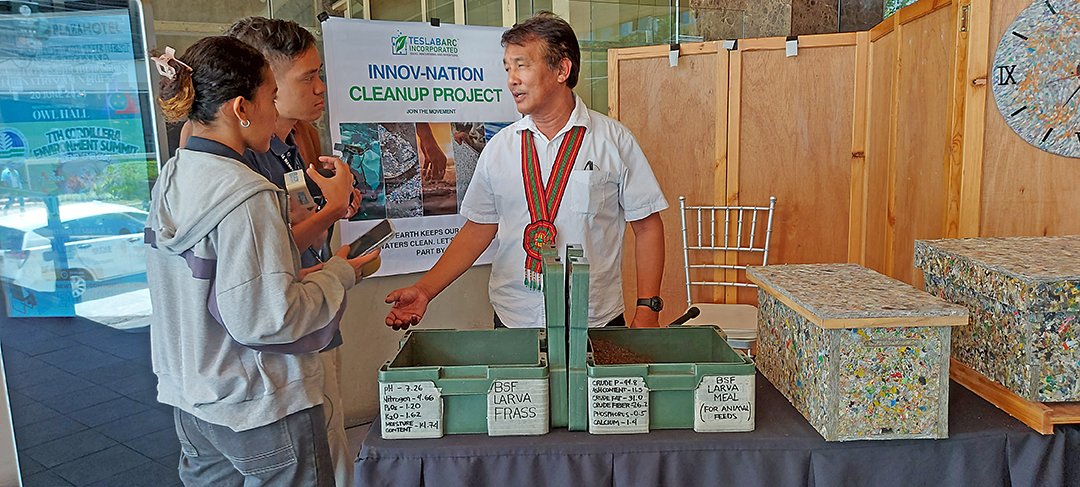
City of Pines abandons waste-to-energy project to embrace zero-waste economy
IT was almost a done deal. “I am formally abandoning the Waste to Energy project,” Baguio City Mayor Benjamin Magalong announced on July 31.
This would entail rescinding the contract signed between the city and Metro Global Renewable Energy Corporation on October 2, 2023.
The contract was for a commitment by the city to supply Metro Global with 500 tons of garbage every day that would feed a waste-to-energy (WTE) technology—one that would turn the waste to fuel and convert it into electricity.
The WTE was supposed to be one of the big-ticket projects of the city government under a public-private partnership scheme.
Despite the lengthy and thorough process of evaluating the feasibility of a WTE project to address the city’s growing solid waste management problem, a single hour-long lecture on the dangers of thermal waste-to-energy processing and the benefits of a zero-waste economy was enough to shift perspectives.
Metro Global had proposed to operate a WTE facility in Sablan, an agricultural town neighboring Baguio, and had prided itself in having an incinerator that would not emit smoke because of the level of intensity of heat it employs.
However, on July 31, Zero Waste Baguio, a band of environmentalists promoting a zero waste lifestyle, sponsored a forum called “Unmasking Waste-to-Energy,” where Dr. Jorge Emmanuel, adjunct professor of environmental science and engineering at the Silliman University in Dumaguete, spoke of the downside of the thermal waste-to-energy process. Emmanuel has dedicated decades of his life into studying incinerators and the toxic elements they emit, particularly dioxin.
Emmanuel narrated that in one of his trips, the Japanese had tried to sell an incinerator to Davao with the guarantee that it doesn’t emit smoke.
“The health problems incinerators give cannot be seen by the naked eye,” he said. There is also the Philippine Clean Air Act or RA 8749 that prohibits incinerators as the burning of waste emits poisonous and toxic fumes. He found it perplexing why government is promoting it.
Incinerators or thermal WTE emit many toxic fumes, including dioxin, considered as the most poisonous substance known, according to Emmanuel.
One drop of dioxin in a medium-sized lake can begin to have its impact on wildlife. That shows its toxicity at extremely small doses.
What is worrisome is the effect on agriculture and the food humans eat because of bio-concentration. Bio-concentration means the chemical has the ability to concentrate as it moves up the food chain.
According to Emmanuel, while dioxins can enter the body through contaminated air, the most common way is through the food we eat. For instance, invisible dioxin emissions can settle on soil where grass grows, which is then eaten by worms. Chickens eat the worms, and the eggs produced by those chickens have a much higher toxic concentration of dioxin than the soil or grass. Consequently, humans can ingest dioxins through meat, poultry, eggs, dairy, and other foods exposed to these toxins.
So, Sablan can heave a sigh of relief, as farming is the main livelihood in the area. An incinerator of this design could certainly jeopardize their reputation as the fruit capital of the North.
This, because studies have shown that dioxin can travel up to 10 km from its source, and as early as 1998 was officially declared as a carcinogen. It has been associated with leukemia and respiratory system cancers, among a range of conditions. And because it invades the hormones, it affects sperm count, fertility, causes miscarriages and birth defects. It has been observed that fetuses exposed to dioxin have half the sperm count as their fathers by the time they are around 18 years old.
The scary facts were enough to move the mayor to abandon the WTE project, and perhaps by a stroke of cosmic coincidence it was around this time that some proposals for SWM came about. “It also doesn’t make sense to have to produce more and more garbage to produce electricity when the goal is to reduce waste,” he said.

The black soldier fly, aerobic cribs and the circular economy
Magalong is a big believer in the concept of circular economy, or the practice of turning waste into resource.
Days after Magalong had announced giving up the WTE project, Rolando James Bayang, more popularly known as Doc Brahman, approached the mayor with the proposal to replicate a solid waste management (SWM) system with the use of black soldier flies (BSF) he is successfully running in Pampanga.
Baguio, the summer capital, becoming a breeding ground for flies and earning the title of “city of flies”? Understandably, the visual and the thought are repulsive. According to Doc Brahman, this is one reason why people and local governments are hesitant to adopt it, fearing it may lead to a pest problem.
To demonstrate the system, Doc Brahman started one setup at the dumpsite in Irisan barangay in Baguio, financing it on his own, because, he says, Filipinos believe in the idiom to see is to believe. He also presented a documentary by Atom Araullo produced by iWitness on BSF.
The BSF breeding station in Pampanga clearly shows the life cycle of the BSF. The place where the flies mate must be kept clean and not so hot. Unlike houseflies, the BSF has a life span of only nine or 10 days and their only mission in being is to propagate. Once they mate, the male BSF dies. Two days after mating, the female lays its 500 to 900 eggs and also dies after.

The eggs are harvested and very carefully nurtured in a nursery until they hatch after four days. At this larvae stage, all they do is eat and they can eat as much as 10 times their weight.
Black soldier flies are saprophytes, meaning they feed only on decaying, rotten, or dead organic matter. People often cringe when houseflies land on their food, fearing where they may have been. However, BSF larvae will not consume clean food. As adults, due to their short lifespan and the urgent task of mating and reproducing, they do not eat at all. After about two weeks, their brown droppings are sifted, dried, and used as fertilizers.
In the pupa stage, a portion is dried and turned into animal feeds. “We dry and grind them and deliver to feed factories,” Doc Brahman said. Another portion is left to thrive for propagation.
So BSFs solve trash problems, are good fertilizers and are used for animal feeds, asserted Doc Brahman, whose dream is to have a BSF facility in every town. Neighboring La Trinidad, a major producer of high-value crops, will also benefit as farmers here can produce more organically grown vegetables.
With all the trash the country has, Doc Brahman must exert quite an effort to have rotten feeding material to give the larvae. This is because the trash is not segregated, he said. If the BSF project prospers, it will also encourage segregation at source.
Recently, Fred Fangonon presented to the city council a revival of his aerobic crib technology, a system that earned him recognition as an outstanding citizen when he first introduced it while serving as the barangay captain of Loakan.
He proposed to the council the massive crib composting technology. It involves large amounts of biowaste to be systematically distributed in cribs that allow air to compost the pile. It will also be aided by earthworms, microbes and, yes, BSF larvae.
The idea is to make an aerobic compost bed for a year, then another the second year before harvesting the composted material from the first bed to set a cycle of continuous supply.
Fangonon will be operating the project under his Dragonfly Eco-compost Corporation and has requested the council to help secure a large size of land where the composting can be done and eventually introduce the project to the barangays.
He assured that BSFs will not become a pest due to their short lifespan. They do not approach kitchen food, as the larvae feed exclusively on smelly, rotten matter, which they convert into high-protein, calcium-rich fertilizers and animal feed. “They are endemic to the country. When I started composting, they just came,” he said.
His dream is to compost all the biowaste of the city.
Eugene Buyucan, head of the General Services Office responsible for the city’s waste management, stated that both technologies are complementary rather than competitive. “35 percent of the daily 500 tons of garbage collected is biowaste,” Buyucan said.
Councilor Lourdes Betty Tabanda, who chairs the Solid Waste Management (SWM) Committee, emphasized that the city needs all available support to address its garbage problem. She requested an initial cost estimate from Fangonon to facilitate the city’s support for the project.
Lastly, as the city embarks on the rehabilitation and upgrade of its Baguio Sewage Treatment Plant, technology is also being developed to have drying beds for sludge and to be processed as fertilizers.
Indeed, the city may soon be not just the City of Pines but also a City of Flies, the good kind.
Image credits: Sandi Wildan via Dreamstime.com, Fevziie Ryman via Dreamstime.com









